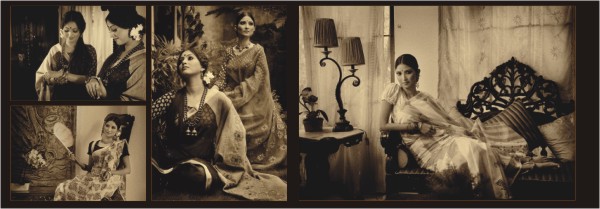 enduring weaves
enduring weaves
of time
A sari draped around the female contour has a language of its own. It speaks in a tongue that bears universal appeal; the elegance in its every fold accentuating the sensuality, poise and romance of a Bangali woman.
The quintessential garb adds to the mystery of the feminine form, her personality,her thoughts, just as much as it speaks of her inner being. Clad in a simple weave of taant, she radiates her Bangaliana -- simple statements that go miles in creating a persona. In timeless Jamdani she is Grace! The intricate weave that has mesmerised people for centuries, still shares the same spot in our hearts, a symbol of nationalistic verve and skilled craftsmanship.
The Bangali women is always best in what is truly ours; our heritage pieces that has enthralled fashionistas, East and West.
This week in Star Lifestyle, Maheen Khan takes a look at the traditional weaves; observes the impact of these fabrics on the local fashion scene.

 Bangladesh enjoys a profusion of creative designs for the production of textiles. The interaction of people- invaders, indigenous tribes, traders and explorers- has built a complex culture, legendary for vitality of colour in its weaves.
Bangladesh enjoys a profusion of creative designs for the production of textiles. The interaction of people- invaders, indigenous tribes, traders and explorers- has built a complex culture, legendary for vitality of colour in its weaves.
Today, as in the past, dyers, weavers, embroiderers and spinners contribute their handmade textiles to our rich and diverse tradition. From the earliest trading records, it is clear that the Greeks, Romans, Arabs, Persians and Chinese traded precious metal and silk for our finest cottons.
The special quality of the light cotton fabric, the embroidery techniques, our ability to respond with sensitivity to demands for new designs and patterns, as well as the nature of natural dyes ensured that Bengal was one of the foremost centres of textile production in the world until the European Industrial Revolution.
Today, in Bangladeshi towns and village's weavers, dyers and embroiderers work to continue the developing traditions of our textile crafts.
We have experienced tremendous growth and development at home and the small workshop industry. A small country like ours does have a variety of textile traditions that may be explored and analysed.
We are a proud nation and we should fearlessly make our textile a fashion statement not only in our home country but also else where.

Entwine a thread of textile heritage
In Bangladesh, we have three defining techniques of textile decoration: weaving and decorating, printing processes and embroidery. The skill of weaving textiles reached its zenith in the seventeenth century by the muslin and jamdani master weavers on the banks of Sitalakkha, in the villages around the historical city of Panam Nagor, Sonargaon.
Today, we continue to produce for the most part, textiles much in the same manner as was done a hundred or more years ago, although certain textile preparation and methods are now becoming rare and less defined. If this continues, we will find our finest styles disappearing altogether.
This is a result of the lack of inherited technical skills and decline of quality. But we also do find that in many cases the weavers here have been re-invigorated by design and adopted technologies that will allow many communities of artisans to flourish once more.
The most acclaimed of the lightweight patterned cloth is the “Dhakai Jamdani”. The looms used are simple but the pattern detailing is extremely labour-intensive.
It requires dexterity and skill to weave these elaborate and intricate motifs. It is essentially like tapestry work, the wefts forming the patterns. It is like loom embroidery where every single thread is drawn and placed by hand with a wooden needle.
Short lengths of weft threads are extended to complete a design by being looped and tied around a warp. The joints are skilfully sewn and woven so as to be invisible. The beautiful patterns are very specific formations of motifs that have emerged over time.
Most of the sari weaves of Bangladesh are weft faced. Throughout Bangladesh, traditional textiles are woven on horizontal, or low warp loom that vary in technical advancement from single heddle to the semi-mechanised Jacquard looms.
In the past, yarns used by weavers would have been exclusively hand spun and of naturally dyed cotton or silk, but are now likely to be machine spun and synthetically dyed cotton, rayon and silk.
 Tangail produces fine cotton saris on relatively simple treadle looms. These looms are laid in the ground and the pedals that the weavers operate are set in a pit. He sits on the ground with the cloth beam on low support above his thigh. The majority of fine cotton saris in Tangail are produced on the treadle loom, also known as the pit loom. While the more mass-produced handloom saris are woven on Chittroranjon making it a mainstay of the Bangladeshi textile crafts industry.
Tangail produces fine cotton saris on relatively simple treadle looms. These looms are laid in the ground and the pedals that the weavers operate are set in a pit. He sits on the ground with the cloth beam on low support above his thigh. The majority of fine cotton saris in Tangail are produced on the treadle loom, also known as the pit loom. While the more mass-produced handloom saris are woven on Chittroranjon making it a mainstay of the Bangladeshi textile crafts industry.
We have a rooted textile tradition in our folk embroidery; it is a time-honoured technique that dates back to primordial times. 'Kantha' is inherently intertwined as an indigenous textile of Bangladesh. The embroidered quilts reflect upon our rich culture that has a very ancient history.
Our country is traversed by the multitude of rivers, a flat delta situated in the foothills of the Himalayas, we display strong cultural ties with the hill people of the region. Its geometric pattern of embroidery resembles the tribal weaves across the border in the northern hills. This needlework embroidery in the past was applied to make quilts with cast-off saris. The technique of creating such a quilt is interlaced with a methodology of stitches.
The original pictorial concept may be an original, a one of a kind composition but the content of stitching styles have manifested over time. The ground is treated with specific 'kuchi' or ' pipri' taga while there are many stitches like 'chok' 'anas' and 'pati' taga that create specific designs each named to resemble a certain characteristic.
Interlacing stitches creates the 'Tagas'. 'Kanthas' were used as winter quilts, covers, and wraps for books and valuables and as mats for ceremonial purposes. Today, 'Kantha' has been revived and widely practiced. It is used on wall hangings, bed covers, in life style accessories and mainly saris. 'Kantha' textiles are sought to adapt to meet the demands of a wide market here and abroad.
The remaining strengths of the Bangladeshi textile tradition are the weaves and the commercial embroidery. Both continue to find large followings in the local market that provide the base within which textiles of technical excellence and beautiful design rival the products of the past.
We should continue to maintain diversity in quality crafts to preserve and persevere the strength of traditional demand for our distinct weaves with its vast variety of consuming workmanship, otherwise it may all too soon be a craft of the past.
Saris presented for the shoot are based on the following references:
 Mughal Painting.
Mughal Painting.
Calligraphy, geometric patterns, and vegetal designs. The depiction of humans and animals was a taboo. However, the production of elaborate illustrated books were the hallmark of a sophisticated Islamic court, particularly in Persia.
Geometric basis of patterns…Persian/Arabian Gulf.
Mixing geometries of different bases is not uncommon in Islamic design. The process adds to the possibilities for invention and so enlivens the designs in which it is deployed. In so doing, the underlying construction can become more complex.
Hibiscus Design
Rose of China is believed to be a native of Southern China, and is thought to have grown there since before the 13th Century. Hibiscus flowers eventually populated India and the Pacific Islands, and then onwards to Hawaii. They usually last for only one day, opening in the morning and wilting late in the afternoon.
Adopted from Mithila Paintings
Some of the main attributes of the entire Madhubani paintings double line border.
Photo: Sazzad Ibne Sayed
Model: Chaity and Mounota
Make up: Farzana Shakil
Styling: Maheen Khan
Jewellery: Maheen Khan’s personal collection
Ensemble: Selim Ahmed Dhara
